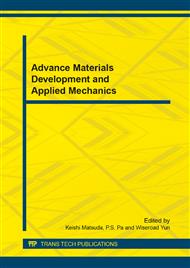[1]
Chen K Y, Liu H B, Li X P, et al, Molecular dynamics simulation of local structure of aluminum and copper in super cooled liquid and solid state by using EAM, J. Phys-Condens Matter, 1995, 7: 2379-2394.
DOI: 10.1088/0953-8984/7/12/003
Google Scholar
[2]
Chen F F, Zhang H F, Qin F X, et al, Molecular dynamics study of atomic transport properties in rapidly cooling liquid copper. J. Chem Phys, 2004, 120(4): 1826-1831.
DOI: 10.1063/1.1636452
Google Scholar
[3]
Wang L, Bian X F, Li H, Molecular dynamics simulation of metal Cu during melting and crystallizing process, J. Acta Chim. Phys. Sin. 13 (2000) 544-550.
Google Scholar
[4]
K. Zhang, H Li, L. Li, X. F. Bian, Why does the second peak of pair correlation functions split in quasi-two-dimensional disordered films, J. Appl. Phys. Lett. 102, 071907 (2013).
DOI: 10.1063/1.4793187
Google Scholar
[5]
K. Zhang, P. C. Si, H. Li, Y. F. Li, H. Q. Yu, Y. Y. Jiang, Elongation behavior and local amorphization of metallic nanowire with glassy shell and crystalline, J. Europhys. Lett. 97, 26005 (2012).
DOI: 10.1209/0295-5075/97/26005
Google Scholar
[6]
Wang L, Bian X F, Li H, Liquid-solid transition and crystal growth of metal Cu by molecular dynamics simulation, J. Acta Phys. Chim. Sin. 16 (2000) 825-829.
Google Scholar
[7]
Plimpton S J. Fast parallel algorithms for short-range molecular dynamics, J. Comput. Phys. 1995, 117: 1.
Google Scholar
[8]
X. W. Zhou et al, Atomic scale structure of sputtered metal multilayer, J. Acta. Mater. 2001, 49, 4005-4015.
Google Scholar
[9]
Hoover W G. Generalization of Nose's isothermal molecular dynamics: Non-Hamiltonian dynamics for the canonical ensemble, J. Phys. Rev. A 1989, 40: 2814.
DOI: 10.1103/physreva.40.2814
Google Scholar
[10]
Honeycutt J D and Andersen H C, Molecular dynamic study of melting and freezing of small Lennard-Jones clusters, J. Phys. Chem. 1987, 91: 4950.
DOI: 10.1021/j100303a014
Google Scholar
[11]
C. H. Bennett, Serially deposited amorphous aggregates of hard spheres, J. Appl. Phys. 1972, 43, 2727.
DOI: 10.1063/1.1661585
Google Scholar
[12]
Y. Waseda, The Structure of Non-Crystalline Materials, Liquid, and Amorphous (McGraw-Hill, New York, 1980).
Google Scholar
[13]
S. P. Pan, J. Y. Qin, W. M. Wang, T. K. Gu, Origin of splitting of the second peak in the pair-distribution function for metallic glasses, J. Phys. Rev. B 2011, 84, 092201.
DOI: 10.1103/physrevb.84.092201
Google Scholar
[14]
K. Watanabe, H. Tanaka, Direct observation of medium-range crystalline order in granular liquids near the glass transition, J. Phys. Rev. Lett. 2008, 100, 158002.
DOI: 10.1103/physrevlett.100.158002
Google Scholar


